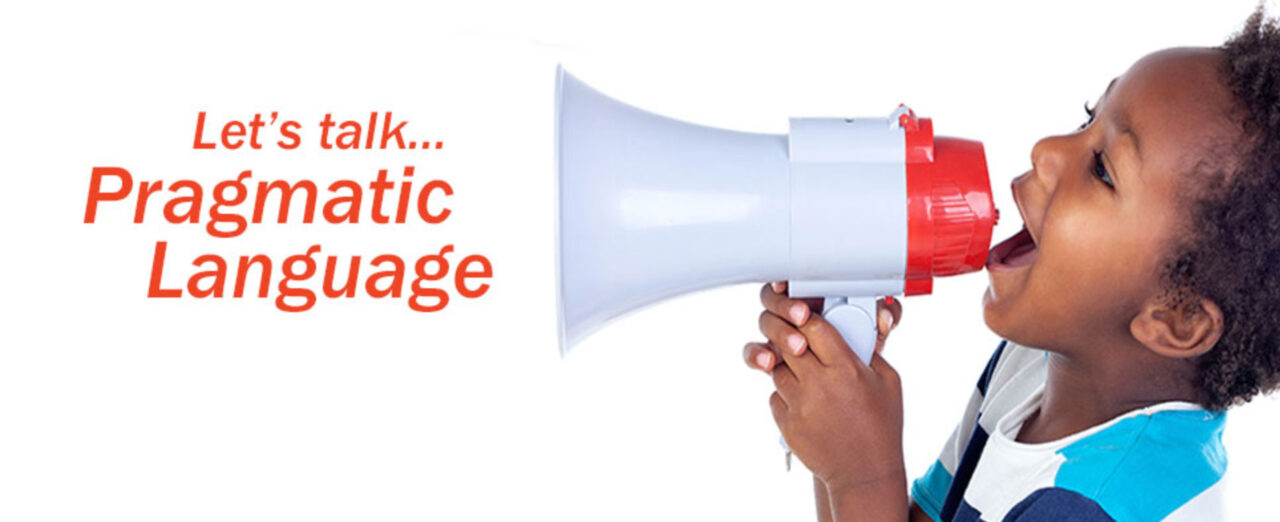Pragmatic language, the cornerstone of effective communication, encompasses the intricate nuances that enable us to navigate social interactions with ease. It delves into the realm of unspoken rules, cultural conventions, and nonverbal cues, providing a comprehensive framework for understanding and expressing ourselves in a meaningful and appropriate manner.
Within the tapestry of pragmatic language, we explore its multifaceted components, tracing its development from infancy to adulthood and examining the factors that shape its acquisition. We delve into the assessment of pragmatic skills, empowering professionals with tools to identify and address communication challenges.
Finally, we delve into evidence-based intervention strategies, empowering individuals to unlock their full communication potential.
Defining Pragmatic Language

Pragmatic language refers to the ability to use language effectively in social situations. It involves understanding the context of a conversation, interpreting nonverbal cues, and using appropriate language for the situation. Pragmatic language skills are essential for successful communication and social interaction.
Examples of Pragmatic Language Use
Examples of pragmatic language use include:
- Using appropriate greetings and farewells
- Understanding and using sarcasm
- Interpreting body language and facial expressions
- Adjusting language style to different audiences
- Using humor appropriately
Difference between Literal and Pragmatic Language
Literal language is the straightforward meaning of words, while pragmatic language considers the context and intention of the speaker. For example, the literal meaning of the sentence “It’s cold in here” is that the temperature is low. However, in a pragmatic context, it could be an indirect request to close a window or turn up the heat.
Components of Pragmatic Language
Pragmatic language is a complex system that involves more than just the words we say. It also includes the context in which we say them, the nonverbal cues we use, and the cultural factors that influence our communication.Context is essential for understanding pragmatic language.
The same words can have different meanings depending on the situation in which they are used. For example, the word “hello” can be used as a greeting, a way to get someone’s attention, or even as a way to say goodbye.
The context of the situation will help us to determine the intended meaning of the word.Nonverbal cues are also an important part of pragmatic language. These cues can include our facial expressions, body language, and tone of voice. They can provide additional information about what we are saying and how we are feeling.
For example, a smile can indicate that we are happy or friendly, while a frown can indicate that we are sad or angry.Cultural factors can also influence pragmatic language. The way we communicate can vary depending on our culture. For example, in some cultures, it is considered polite to make eye contact when speaking to someone, while in other cultures it is considered disrespectful.
It is important to be aware of the cultural factors that influence pragmatic language in order to avoid misunderstandings.
The Role of Context in Pragmatic Language
Context is essential for understanding pragmatic language. The same words can have different meanings depending on the situation in which they are used. For example, the word “hello” can be used as a greeting, a way to get someone’s attention, or even as a way to say goodbye.
The context of the situation will help us to determine the intended meaning of the word.There are several different types of context that can influence pragmatic language. These include:
-
-*Physical context
This refers to the physical environment in which communication takes place. The physical context can include factors such as the location, the time of day, and the presence of other people.
-*Social context
This refers to the social relationship between the people who are communicating. The social context can include factors such as the power relationship between the people, their familiarity with each other, and their shared cultural background.
-*Linguistic context
This refers to the language that is being used. The linguistic context can include factors such as the choice of words, the grammar, and the tone of voice.
All of these different types of context can influence the meaning of pragmatic language. It is important to be aware of the context in which communication is taking place in order to understand the intended meaning of the words that are being used.
The Importance of Nonverbal Cues in Pragmatic Language
Nonverbal cues are an important part of pragmatic language. These cues can include our facial expressions, body language, and tone of voice. They can provide additional information about what we are saying and how we are feeling. For example, a smile can indicate that we are happy or friendly, while a frown can indicate that we are sad or angry.Nonverbal
cues can also be used to regulate the flow of conversation. For example, we may use eye contact to indicate that we are interested in what someone is saying, or we may use gestures to indicate that we want to take a turn speaking.Nonverbal
cues are an essential part of pragmatic language. They can help us to communicate our thoughts and feelings more effectively, and they can also help us to regulate the flow of conversation.
The Influence of Cultural Factors on Pragmatic Language
Cultural factors can also influence pragmatic language. The way we communicate can vary depending on our culture. For example, in some cultures, it is considered polite to make eye contact when speaking to someone, while in other cultures it is considered disrespectful.
It is important to be aware of the cultural factors that influence pragmatic language in order to avoid misunderstandings.There are several different ways in which cultural factors can influence pragmatic language. These include:
-
-*The use of language
The way we use language can vary depending on our culture. For example, in some cultures it is considered polite to use indirect language, while in other cultures it is considered more direct.
-*The use of nonverbal cues
The way we use nonverbal cues can also vary depending on our culture. For example, in some cultures it is considered polite to make eye contact when speaking to someone, while in other cultures it is considered disrespectful.
-*The interpretation of language
The way we interpret language can also vary depending on our culture. For example, in some cultures it is considered polite to say “no” indirectly, while in other cultures it is considered more direct.
It is important to be aware of the cultural factors that influence pragmatic language in order to avoid misunderstandings. When communicating with someone from a different culture, it is important to be respectful of their cultural norms and to avoid making assumptions about what they mean.
Development of Pragmatic Language

Pragmatic language development is a complex process that begins in infancy and continues throughout childhood. It involves learning how to use language in a socially appropriate way, including understanding the rules of conversation, taking turns, and using appropriate body language.
Stages of Pragmatic Language Development
Pragmatic language development can be divided into several stages:
- Pre-linguistic stage (birth to 12 months):Infants communicate through gestures, facial expressions, and vocalizations.
- Early linguistic stage (12 to 24 months):Toddlers begin to use single words and short phrases to communicate.
- Multi-word stage (24 to 36 months):Preschoolers begin to use multi-word phrases and sentences to communicate.
- Advanced linguistic stage (36 months to 5 years):Children begin to use more complex sentences and understand the rules of conversation.
- School-age stage (5 years and up):Children continue to develop their pragmatic language skills, including the ability to use language for a variety of purposes.
Factors that Contribute to Pragmatic Language Development
Several factors contribute to pragmatic language development, including:
- Input:Children learn pragmatic language skills by interacting with others who use language in a socially appropriate way.
- Modeling:Children learn by observing others use language in different situations.
- Feedback:Children need feedback from others to learn how to use language effectively.
- Cognitive development:Children need to have a certain level of cognitive development to understand the rules of conversation and use language appropriately.
Impact of Language Disorders on Pragmatic Language Development
Language disorders can impact pragmatic language development. Children with language disorders may have difficulty understanding the rules of conversation, taking turns, and using appropriate body language. They may also have difficulty using language for a variety of purposes, such as requesting information or expressing their opinions.
Assessment of Pragmatic Language
/Pragmatics-5900e0fc3df78ca1590318b2.jpg)
Pragmatic language assessment is a vital component of evaluating communication skills. It involves assessing an individual’s ability to use language effectively in social situations.
Various methods and tools are employed to assess pragmatic language skills. A comprehensive assessment typically includes observations, interviews, and standardized tests.
Methods for Assessing Pragmatic Language
| Method | Description |
|---|---|
| Observation | Observing an individual’s language use in natural settings, such as conversations or social interactions. |
| Interview | Asking questions to gather information about an individual’s pragmatic language skills, such as their understanding of social cues and their ability to adapt their language to different contexts. |
| Standardized Tests | Administering standardized tests that measure specific aspects of pragmatic language, such as the Pragmatic Language Assessment Instrument (PLAI) or the Test of Pragmatic Language (TOPL). |
Common Assessment Tools for Pragmatic Language
- Pragmatic Language Assessment Instrument (PLAI)
- Test of Pragmatic Language (TOPL)
- Clinical Evaluation of Language Fundamentals (CELF)
- Diagnostic Evaluation of Language Variation (DELV)
- Social Communication Questionnaire (SCQ)
Procedures for Conducting a Pragmatic Language Assessment
- Gather background information about the individual, including their age, developmental history, and any known communication difficulties.
- Observe the individual in various social situations to assess their pragmatic language skills.
- Interview the individual and their caregivers to gather information about their pragmatic language use.
- Administer standardized tests to measure specific aspects of pragmatic language.
- Analyze the results of the assessment to identify the individual’s strengths and weaknesses in pragmatic language.
Intervention for Pragmatic Language Difficulties

Intervention for pragmatic language difficulties aims to improve communication skills and social interactions in individuals with pragmatic language deficits. It focuses on developing appropriate language use in different social contexts, improving nonverbal communication, and enhancing social problem-solving abilities.
Goals of Pragmatic Language Intervention
- Enhance understanding and use of social cues, including facial expressions, gestures, and tone of voice.
- Develop appropriate language for different social situations, such as greetings, requests, and apologies.
- Improve nonverbal communication skills, such as eye contact, body language, and gestures.
- Foster social problem-solving abilities, including perspective-taking and conflict resolution.
Evidence-Based Intervention Strategies
Evidence-based intervention strategies for pragmatic language difficulties include:
- Social skills training:Structured programs that teach social skills, such as initiating conversations, maintaining eye contact, and resolving conflicts.
- Peer-mediated intervention:Involving peers as models and facilitators to promote social interaction and language development.
- Conversation scripts:Providing individuals with scripts or guidelines for different social situations to improve their language use.
- Role-playing:Allowing individuals to practice social interactions in a safe and controlled environment.
- Technology-assisted intervention:Utilizing technology, such as social media platforms and video conferencing, to enhance social interactions and language development.
Role of Technology in Pragmatic Language Intervention
Technology plays a significant role in pragmatic language intervention by providing:
- Interactive platforms:Social media and video conferencing allow individuals to engage in social interactions and practice language skills in real-time.
- Virtual environments:Virtual reality and augmented reality simulations can create safe and controlled environments for individuals to practice social skills.
- Language modeling:Speech recognition software and language modeling tools can provide feedback and support for improving language use.
- Access to resources:Technology provides access to online resources, such as videos, articles, and social skills training programs.
Epilogue
In conclusion, pragmatic language stands as a cornerstone of human interaction, enabling us to navigate the complexities of social communication. Its development, assessment, and intervention are essential elements in fostering effective communication and building meaningful connections. As we continue to unravel the intricacies of pragmatic language, we empower ourselves to communicate with clarity, confidence, and cultural sensitivity, unlocking a world of possibilities for personal growth and societal harmony.
Frequently Asked Questions: Pragmatic Language
What is the difference between literal and pragmatic language?
Literal language focuses on the explicit meaning of words, while pragmatic language considers the context and intent behind the words.
How does culture influence pragmatic language?
Cultural factors shape the way we interpret and use nonverbal cues, politeness strategies, and conversational norms.
What are common assessment tools for pragmatic language?
常用的评估工具包括语言样本分析、社交技能清单和角色扮演任务。